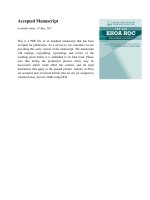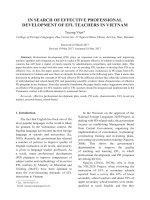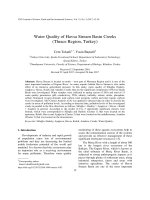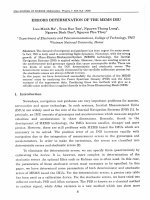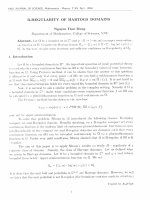DSpace at VNU: Performances analysis of Vehicle-to-X Communication Systems
Bạn đang xem bản rút gọn của tài liệu. Xem và tải ngay bản đầy đủ của tài liệu tại đây (1.89 MB, 5 trang )
Performances analysis of Vehicle-to-X
Communication Systems
2
2
2
l
3
Hieu Nguyen , Van Due Nguyen , Tien Hoa Nguyen , Duyen Trung Ha , and Thomas Kaiser
IUniversity of Engineering and Technology, Vietnam National University, Hanoi, Vietnam
Hanoi University of Science and Technology, Hanoi, Vietnam
2
3Institute of Digital Signal Processing, Faculty of Engineering, University of Duisburg-Essen, Duisburg 47057, Gennany
Abstract:
carrier
This paper investigates the influence of the inter
interference
on
a
vehicle
to
infrastructure
(V2X)
communication system, which has been defined in the IEEE
802.lIp standard. The frequency shift due to high speed of cars
destroys the orthogonality between subcarriers in OFDM signals
and
rises
the
inter-carrier
interference
(leI).
The
main
contributions of this paper are proposed analytic formulas and
simulation results of the signal to interference power ratio (SIR)
to model the V2X channels based on different Doppler spread
shapes.
This paper is organized as follows. In section II, formula of
and SER for four types of Doppler spread model with
Rayleigh and Rician channel in the OFDM system are
presented. Section III provides results and discussions. Finally,
section IV concludes this paper.
SIR
by considering the statistical effects of leI and evaluation of
II.
symbol error rate (SER) for several types of fading and Doppler
spread in time domain approach. The results show that for the
Rayleigh
fading
model,
SIR
decreases
when
the
maximum
Doppler spread increases. On the other hand, in the Rician
channel, SIR depends not only on maximum Doppler spread but
also on the angle of arrival (AoA) and Rician factor of the LOS
component. Moreover, the simulation result in terms of SER is
obtained for different channel models. It shows an excellent
agreement between the theoretical calculation of SIR and the
DOPPLER SPREAD MODELS
In this section, analytic formulas of evaluating two
parameters for vehicles communications SIR and SER are
presented for each type of Doppler spread models. SIR
evaluation
1) Received signal in OFDMsystem
The transmitted OFDM signal is given by
simulation results of SER.
Keyword- leI and SIR analysis for OFDM-based vehicle X
n = O, ...,N-I
system, V2X channel models.
I.
(1)
INTRODUCTION
The intelligent transportation system with a support of
high-speed communications has been proposed by both
academic researchers and industry [7], [8], [9], [lO], [11]. This
system can provide the link between vehicles (V2V) or vehicle
and infrastructure (V2X). The standards are based on the IEEE
802.11 wireless local area network (WLAN) in the 5.9 GHz
unlicensed band with communication range of about Ikm [12],
[13]. In this system, two most significant impacts are the high
Doppler spread due to the very high speed of the vehicle, and
the existence of line-of-sight (LOS) component due to short
range transmission [14]. The effects of these two properties on
relevant communication systems need to be analyzed. Signal to
interference power ratio (SIR) and symbol error rate (SER) are
two very important parameters in evaluating the performance
of communication systems. However, these two parameters
have so far not been investigated for vehicle communication
system. In this paper, analytic formulas and simulation results
for the signal to interference power ratio and evaluation of
symbol error rate are proposed with considering several types
of fading and Doppler spread shape such as: Classical Jakes's
model, Uniform shape model, Round shape model and Two
path mode. In order to evaluate SER we have to generate AoA
of all paths, which are suitable to the statistical properties of
AoA in real-world channel. Therefore, a method is proposed,
which generates these AoA. We firstly generate pseudo
sequence of AoA based on the probability distribution function
(PDF) of AoA. After that Lp-norm method (LPNM) is used
where X[k] denoted the transmitted data at the klh sub-carrier,
x[n] is the n ih sample of the OFDM system, and N is the
number of sub-carrier of each OFDM symbol. This signal is
transmitted over multipath fading channels.
The multipath fading channel can be expressed as:
L
h [n ] = � > [n ,l ] o [IT
, �O
- 1', ]
(2)
where h[n, I] is the tap gain of the l 'h tap at time n, and
delay of l 'h tap.
The received signal sampled at time index
written by
n
1'
,
is
can therefore
L
r [n ] = � > [n ,l ] x [n -I ] + w [n ]
(3)
,�O
where w[n] is the complex white Gaussian noise with zero
mean and variance No
After Fourier transformation, the Eq. (3) can be rewritten as
r[n] =
1
N-J
"liN
k�O
. 21rnk
f7? L H n k X k /--;V
[ , ] [ ]
n ],n
+ w[
=O, ...,N -1
(4)
Let X[k] denote the demodulated data of klh sub-carrier, than
978-1-4673-5604-6/12/$3l.00 ©2012 IEEE
000326
N-I _/7rNnk ,k=O,
X [k]= h7 k�OLr[n]e
1
A
...,N-l
"N
(5)
Plugging Eq. (1) and (4) to (5) we have that
X[k]= ��[(�H[n,m{7r(I�-k)n j X[m]]+W[k]
=S[k]+I[k]+W[k]
where
S[k]=� III��OH[n, k]x [k]
27r(m-k)n
N-I
N-I
i[k]=- m=O,Lm::t;.k n=OLH[n,m]/-N-X [m]
W[k]= JN�N-I w[n]e_/lfNnk
N
1
N
1
(6)
(13)
Replacing the autocorrelation function of several Doppler
spread spectral shapes to (12) and (13) we can determine the
Signal to Interference Ratio (SIR) for each case. Following
will only present the expressions for relevant
and
in
two-path model as theorem without roof. The roof will be
presented in another pUblication.
PS Pi
a) Rayleigh fading
Ps
(7)
PI
(8)
(9)
[ ( -lpl)RY (pT)
=-4
N p�I-N3 N
.2lf(m-k)
N-I N-I
D (N -lpl)RY (pT�J N P
=-40
N m�O p�I-N
(14)
mOk
Thereby:
Let denote PSI Pi the power of desired signal and the
interference signal at klh sub-carrier, we have that
P
,
=E t BealE' � = E[II[kfIJ·
To obtain PI' we use
following equation:
Suppose that the Fourier transform of the channel impulse
response at different frequencies is independent of each other,
i.e.,
where
EFf!(n,.,ml)H*(n2,m2)FYR(n,.-m2)O(ml-m2)
R((n,. - m2)T)
Rician fading
b)
is the autocorrelation of the Doppler spread of
the channel at time instants n,Tand n2Trespectively. Suppose
also that the signal at different sub-carriers is uncorrelated and
has unit power i.e., E[¥(nl'ml)X(n2,
Denote
Y
RI(r) and R (r) the autocorrelation of the Doppler spreads for
the Rayleigh channel and the Rician channel, respectively.
Then the power of the interference can be rewritten as:
m2)FY 5(m, - m2).
Thereby:
N-I
I(N-lpl)RI(pT)
SIR P, _--'-p=I_-N____...,.
....,
..,.
,z(m-k)
P.
N-I N-I
2
N
p
I II(N-lpl)RI(pT�Jm=O
m# p=l-N
=
=
l
KxI I (N_lpl�j2Z(J,pTW'O"+��k} I I (N_lpI)RY(PT/tk p
-��
m:tk
+
-��
m:tk
By the same analysis as in the previous part, the powers of
signal and interference are reduced to:
Eq. (11) can be rewritten as:
PI
2 -k)p
(
=�
- l p l ) R Y (pT�j lf ;
(N
[3
[3
N m�O p�I-N
mOk
(12)
Repeating the same procedure as in deriving Eq. (12), we have
We see that the SIR depends on the autocorrelation of
Doppler spread. We now obtain the autocorrelation of Doppler
spread for each type of channel model.
000327
2) Autocorrelation function for four models
a) Classical Jakes's model
1
(J)=
�
1
r7f"Y ' If I
Jr d
1v (fJ
;;
<
1) Generation of AoA based on LPNMmethod
In this section, Lp - norm method (LPNM) which generates
an will be discussed. A stochastic continuous-time simulation
h
(19)
(20)
b) Uniform shape model
{�
(21)
(22)
Round shape model
P,(f)� {l-(;']' ���
(23)
;"
2 r
R� (r)= J1 ( Jrh )
2Jrhr
Two -path model
Pr(J)= p.t5(J + h)+(I-p)t5(J -h)
R!;. (r) = p.e- j27l!d' + (1- p).ej27l!d'
(24)
(25)
(26)
SER evaluation
In this section, the rice fading process for four Doppler
spread models will be presented. SER results will be obtained
for each model by simulating with QAM-16 OFDM system.
The baseband Rician fading process is given by [2]:
Doppler frequency. The initial values for an of four models
are proposed in the next section. The stochastic time process
v(t) can be expressed as:
N
Where OJn = In, cos(an ) is the diffuse Doppler with random
()n
�
v(t)= D cn cos(2Jrfd cos(an)t +()n)
n=1
(29)
R(JJr)=E {v(r)V(r-HJr)}
(30)
an is finally obtained such that the Lp-Norm reach the local
D
E
;P) o.-.!.=
�rmax
an p s (a) for
path n, ps(a)is given in (32) and (33).
U( -Jr, Jr) is the random diffuse phase. G is average
�
fading signal power [2]. K is the ratio of specula power to
the diffuse power and K is positive.
Drmax
D
0
D' P
IR (0 r) - R (D rf d (0 r)D
�
,p
L N
+
(31)
R(D is given at (20), (22), (24), (26) and R(O r)is
given at (30). Asswning that among interval [0, Llrmax] the
R(JJ r)= R(JJ r). In this case, Llrmax is set 0.08s [1].
2) initial values of AoA
With
The initial values of an of Classical Jakes's model are given
by the following [4]:
an =Jr(n-1I2)/2n
(32)
For Two-path model, these are only two paths. We simply
seek the angle of arrivals of these paths as
Error! Reference source not found ..
al,2 =[Jr I 90, Jr I 45]
(33)
On the other hand, we have only the PDF of AoA listing as
followings:
./
./
AoA
denotes the maximum
minimwn by using numerical optimization method.
Where fd is the maximwn Doppler frequency, p presents
the normalized power of one path, (J denotes the Dirac
function, P(j) is the power spectral density, R (r) is the
autocorrelation function and Jo, Jj
compute the Bessel
function of the order 0 and order 1, respectively.
B.
fd
The time correlation of v(t) defined as [17].
'I
,
(28)
Where Cn denoted channel gain, frequencies In are non-zero
real-valued constant quantities and the phase en are
independent, identically distributed random variables, each
having a uniform distribution over the interval (0,2Jr). Let
denote In = h cos(an ) , where
lf l
Pu (J)= 2 / < h
o
,otherwise
R� (r) = sinc (J/Z")
d)
N
v(t)= D cn cos( 2Jrfnt +()n)
n=l
, otherwise
o
c)
for a lognormal process can be modeled by a sum of sinusoids
[1]:
Uniform shape model AOA [2J:
Pu (a)= sin (a) I 4, lal � Jr
Round shape model AOA[2j:
Pr (a)= sin2 (a) I 4, lal � Jr
(34)
(35)
With these models which do not have a , we will generate
sequence an by generating corresponding pseudo sequences
using the correspondingp(a).
000328
" 'l:l\"';
t\ +
::
.. ...\.
.. j
·-f
-. ..
· '·
. ;····i ·· ··
i ·· ; ··· · · I �
�
_
+
·· +
l!
.
+
,··········i
+
j .....
.. +.. · + · · + ··· ··ii ··· · !
i
··f·· lt i ····i·�:···i·······
· i····+···"····+ ····i
········1········· n
·,,··········'/""'·· ······'".-......
.; ·....i
.,"-" , . . . , ,,'""',,,., . +
�i
.0
........... ..... 1'
.. :\ I
,
i
.
\'
i
!
•
i
: [�
. -....
�
..
!i
1. .
r\j
V
\1 . �f\)N rv
�
.. .. ..
V
".
,
1\
,
5
,
�I
1
Fig
,
,
.,.,
- .... 110
O!il!i ··
·
;"'''''=
'
Fig
1: The signal to interference ratio for the Rayleigh and Rician
fading channels
,'.'f t IH t Ht Ht H I H I 11 11 1+1 11
!
" .. t·;· t · j ;-I h· t 'j ; -I HI- HI-· H·j
" ..f/ ++H +H H · ; ·H Ht ,, ·tt ,,· tt
,!-. ---7, ----7,�,----c,;--�-!--t--!
�1
••
I
3: Time Correlation of four models
Fig. 1 illustrates time correlation of four models after
generating parameters. In the figure, the simulation model has
nearly the same statistics as the reference model.
III.
SIMULAnON RESULTS AND DISCUSSION
Here we consider the parameters for the WAVE IEEE
802.11P standard. This system operates at center frequency of
5.9 GHz. Some typical parameters are listed in Table I.
Table
Standard
802.1lQ
802.lIa
Carrier frequency
5.9 GHz
2.4 GHz
Bandwidth
10MHz
20MHz
Symbol duration
8f.1.s
4f.1.s
Guard Time
1.6f.1.s
0.8f.1.s
Number ofFFT])oint
64
64
Number ofsub-carrier
52
52
48
48
0. 15625MHz
0.3125MHz
Number ofuseflll subcarrier
Frequency spacing
1.
SIR
Fig. 2 illustrates the effect of maximum Doppler spread.fd
on SIR for four kinds of Doppler spread. The maximum
Doppler spread is proportional to the speed of a vehicle. If the
speed of the vehicle increases, the fd increases, the SIR
decreases too. For example, if the velocity of the vehicle is
v=300kmlh, the carrier frequency is fc = 5.9GHz and the speed
of light is c=3.108m1s then the maximum Doppler frequency is
determined by:
K with different AoA
eo
for the Rician fadin� channels
Jd
1: Parameters of Wave 802.llp
Parameters
Fig 2: The signal to interference ratio versus
vfc
= -;;- =
300x103 x5.9x109
3600x 3x108
The symbol duration of OFDM symbol in WAVE standard
is Ts = 81ls and hence JdT "" 1.31x10-2
•
When the Rician factor increases to K=200 and the AoA of
LOS component is eo=nI2, the SIR of the Rician channel and
Rayleigh channel are show in Figure 5, where the solid curves
are for the Rayleigh and the dash curves are for the Rician
fading. At this AoA of the LOS, the specular component
improves the SIR of the system significantly, e.g. the SIR is
improved about 25 dB for the Doppler spread of two-path
model. This result agrees with the intuition that the LOS
component usually maintains the quality of transmission.
The different results are illustrated in detail in Fig. 3,
where the maximum Doppler spread is set at.fd= 1000Hz and
AoA of LOS component are Bo=O; 0.457r, 0.57r respectively. In
figure 4, at the same value of the lowest curve is the SIR for
the two-path model and the highest curve is the SIR for
uniform model. In the two-path model, the SIR is constant
when eo=o and increases with K monotonously when eo takes
other values. In other three model, i.e. classical Jakes, round
and uniform, at Bo=O, if K increases the SIR increases to a
saturation level corresponding to that of the two-path model.
At this situation, the LOS component destructs the quality of
the transmission link. If Bo=0.457r, and Bo=0.57r, the SIR
increases with K monotonously. There is a critical value of
000329
VI.
[I]
M. Pittzol and Van Duc Nguyen "A Spatial Simulation Model for
Shadow Fading Processes In Mobile Radio Channels". Personal, indoor
and Mobile Radio Communications, 2004. PIMRC 2004. 15th IEEE
International Symposium on1. Clerk Maxwell, A Treatise on Electricity
and Magnetism, 3rd ed., vol. 2. Oxford: Clarendon, 1892, pp.68-73.
[2]
Jared Dulmage and Dr. Michel P.Fitz "Non-Isotropic Fading Channel
Model for the Highway Enviroment".
Vehicular
Technology
Conference, 2007. VTC-2007 Fall. 2007 iEEE 66thK. Elissa, 'Title of
paper if known," unpublished.
[3]
R. H. Clarke" A statiscal theory of mobile-radio reception". Bell System
Technical Journal, pp, 975-1000, Jul. 1968.
[4]
Matthias Piltzol, Ulrich Kilat, Frank Laue and Yingchun Li "On the
problems of monte carlo method based simulation models for mobile
radio channels" Spread Spectrum Techniques and Applications
Proceedings, 1996., IEEE 4th International Symposium on.
[5]
G. Acosta- Marum and M.A ingram"Doubly selective vehicle-to-veicle
channel Measurements and modeling at 5.9 GHz" in Wireless Personal
Multimedia Communication(WPMC) 2006, 17-20 September 2006.
[6]
M. Patzol, Ulrich Kilat, Frank Laue and Yingchun Li,"On the statistical
properties of deterministic simulation models for mobile fading
channels" iEEE Trans, Veh. Technol., vol. 47, no. 1, pp. 254-269,
Feb.199
[7]
L. Cheng, B. E. Henty, D. D. Stancil, F. Bai, and P. Mudalige, "Mobile
Vehicle-to-Vehicle
Narrow-Band
Channel
Measurement
and
Characterization of the 5.9 GHz Dedicated Short Range Communication
(DSRC) Frequency Band" iEEE J. Sel. Areas Commun., vol. 25., no. 8,
pp. 1501-1516-2007
[8]
A. Paier, 1. Karedal, N. Czink, H. Hofstetter, C. Dumard, T.Zemen,
F.Tufvesson, A. F. Molisch, and C. F. Mecklenbrauker, "Car-to-car
radio channel measurements at 5GHz: Pathloss, power-delay-profile,
and delay-Doppler spectrum" in Proc. 4'h into Symp. Wireless
Communication Systems iSWCS 2007, 2007, pp. 224-228.
[9]
"CAR 2 CAR Communication Consortium Manifesto," CAR 2 CAR
Communication Consortium, Tech. Rep,. Aug. 2007. [Online].
Avaiable:
DO
W
if>
0
1 -30�---:-----7-----o-----,
-!:
:':
--,
:'!o62 --:':41 ----,':':
2:
:- --:';;-----:
8
0---;
0
SNRdb
Fig
4: The symbol error rate for Rician fading channels
'
AoA, denotes as 90 , at this point the SIR for each one of the
three models of the Doppler spread is constant. If AoA is
'
greater than 90 , the SIR increases with K otherwise, the SIR
'
decreases with K if the AoA is less than 90 . This critical value
'
90 is determined by solving the equation that the fIrst
derivative of SIR with respect to K is set to zero. This
equation is quite complex and usually solved by numerical
method.
2. SER
Fig. 4 shows the SER of Rician channels. Where the Rician
factor K=5, AoA of LOS component is 80=7[12 and Power
delay profIle is given in [5]. When SNR increases, SER
decreases. In case of SNR < 10 dB, SERs of four models have
no signifIcant difference. In contrast, when the SNR> 10 dB,
SER of Uniform model decreases deeply so the quality of
system increases considerably; with Two-path model, SER of
it also decreases but slowly. Hence, quality of Uniform model
is much greater than Two-path model.
IV.
CONCLUSION
The communication link in intelligent transportation
systems has been based on WLAN IEEE 802.11P standard. It
uses OFDM as a basic modulation scheme for the
communication systems. If the very high speed causes high
Doppler spread, the orthogonality among sub-carriers is
destroyed. On the other hand, in DSRC system, the existing of
LOS and the Rician fading channel model should be
considered due to the short range of transmission link. In this
paper, the effect of Doppler spread to OFDM signals are
studied for both SIR and BER performance with four well
known Doppler spread models (two-path, classical Jakes,
round and uniform model). When the speed of vehicles
increased, the maximum Doppler frequency is also increased,
thus making the decreasing of SIR. Besides, a different result
illustrates that the considerable differences of symbol error
rate (SER) or quality of four models when SNR of system
increases.
The article only evaluates the performance of OFDM-based
Vehicle-to-X communication systems. As future works, we
plan to study such communication system considering
Vehicle-to-Vehicle scenarios.
V.
REFERENCES
[10] 1. Karedal, F.Tufvesson, N. Czink, A. Paier, C. Dumard, T. Zemen, C. F.
Mecklenbrauker, and A. F. Molisch, "A geometry- based stochastic
MIMO model for vehicle-to-vehicle communications" iEEE Trans.
Wireless Commun., vol. 8, no. 7, pp. 3646-3657, 2009
[11] A. G. Zaijic and G. L. Stuber, "Three-dimensional modeling and
simulation of wideband MIMO mobile-to-mobile channels" iEEE Trans
Wireless Commun., vol. 8, no. 3, pp. 1260-1275, 2009
[12] "Part 11: Wireless LAN Medium Access Control (MAC) and Physical
Layer (PHy) specifications; Amendment 7: Wireless Access in
Vehicular Environments," IEEE, Draft Standard, Nov. 2008.
[13] "Intelligent Transportation Systems (ITS); Vehicular Commnunication;
Basic Set f Applications; Definition," ETSI, Draft Standard, Jan. 2009
[14] G. Acosta- Marum and M. A. Ingram, "Six Time and Frequency
Selective Empirical Channel Models for Vehicular Wireless LANs". in
Proc. VTC-2007 Fall Vehicular Technology Con] 2007 IEEE 66th, 2007,
pp. 2134-2138.
[15] 1. Li and M. Kavehrad, "Effects of time selective multipath fading on
OFDM systems for broadband mobile applications," lEE Commun Lett,
vol. 3, no. 12,pp. 332-324, Dec. 1999
[16] Y.Li and J.Cimini, LJ.,"Bounds on the interchannel interference of
OFDM in time-varying impairments," lEEE Trans. Commun, vo1.49,
no.3, pp. 401-404,2001
[17] M. Paetzold, U. Killat, F. Laue, and Y. Li, "On the statistical
properties of deterministic simulation models for mobile fading
channels," iEEE Trans. Veh. Technol., vol. 47, no. I, pp. 254-269, Feb.
199
[18] M. Patzol"Mobile radio channels", second edition, John Wiley & Sons,
2011.
ACKNOWLEDGEMENT
This research is funded by Vietnam National Foundation for
Science and Technology Development (NAFOSTED) under
grant number 102.02-2011.15
000330


